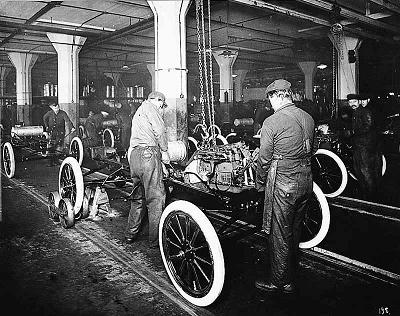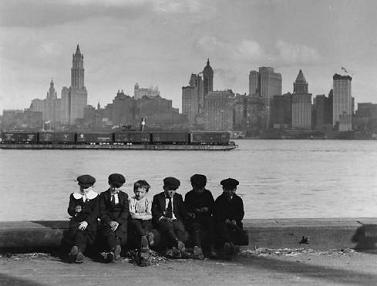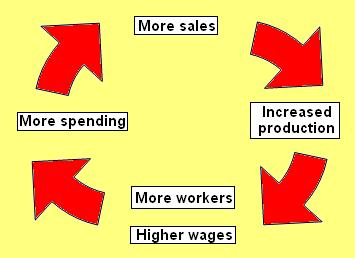Source A

Angie: "For me, the overriding image of 1920s
America is a glossy automobile, rich young men and fashionable young women
relaxing by a swimming pool, and the legend ‘The Better Buick’".
BBC Bitesize podcast (2006)
|
Going Deeper
The following links will help you widen your knowledge:
Basic account from
BBC Bitesize

(How) did tariffs help the American Economy grow?
Podcasts:
 America in the 1920s, triumph or disaster
(recommended) America in the 1920s, triumph or disaster
(recommended)
 Giles Hill on the causes of the Boom Giles Hill on the causes of the Boom
Powerpoint:
Economic Boom
YouTube:
Boom
and Bust - BBC 20thC History
The Model T
Mr
Portman's useful video
AQA-suggested Interpretations of the economic Boom:
Fredrick Lewis Allen, Only Yesterday (1931)
Charles E Sorensen, My Forty Years with Ford (1956)
|
A Booming Economy [CI SUCCESS]
Between 1922 and 1929 the annual Gross National Product of the USA increased by 40%.
The average income per head increased by 27%.
Features of the boom included:
Consumer boom
– growth of personal possessions (c.f. Woolworths,
hire purchase, commercial travellers).
Innovation in production methods
– especially in the motor industry (by 1925 Ford were
producing a car every 10 seconds); this pushed down prices and made goods
more accessible for ordinary people (the ‘Tin Lizzie’ cost $850 in 1910,
only $295 in 1920).

Synthetics
– the invention of bakelite (the first plastic),
cellophane and nylon - and chemicals.
Upsurge in car ownership
– esp. the Ford Model T; 15 million had been
produced by 1927, and the number of Americans owning cars rose from 8 to 23
million.
Consumer durables/electrical goods
– fridges, washing machines, dishwashers, vacuum cleaners,
record players.
Communications revolution
– number of telephone doubled/ number of radios increased
from 60,000 to 10 million.
Entertainment industry
– Hollywood, Charlie Chaplin, the ‘talkies’ and cinemas,
jazz clubs and speakeasies.
Stock market
– Wall Street boomed (a 'bull' market) with many people buying shares to make a profit.
Many new businesses were 'floated' on the stock market.
Skyscrapers,
highways and urban development.

|
Source A
The business of America is business... The man who builds a factory, builds a temple. The man who works there, worships there.
Presidemt Coolidge (1923-29),
Source B
We in America today are nearer to the financial triumph over poverty than ever before in the history of our land. The poor man is vanishing from us.
Under the Republican system, our industrial output has increased as never
before, and our wages have grown steadily in buying power.
President Hoover, speaking in 1928.
During his election campaign, Republicans promised 'a chicken in every pot and a car in every backyard'.
Source C
Most imposing of all, however, is the auto traffic... New York alone has more cars than all of Europe. I am told that every fourth person here owns a car. Workers and simple people have their own machines, which they naturally drive themselves. The auto is not a luxury item it is in somewhat the same category as a bicycle among us, a simple means of transportation that makes possible residence outside the city.
Felix von Luckner, Seadevil Conquers America (1928)
Felix von Luckner was a German war-hero who visited America on a speaking tour in 1926.
|
WHY industry boomed [PAT GOT CASH]
Population
– growing rapidly increased demand for consumer goods.
Abundant raw materials
– esp. coal, iron and oil – allowed cheap production
Tariffs
– tariffs protected American industry from competition
Government
– in the 1920s, Presidents Warren Harding (1921-3), Calvin
Coolidge (1923-9) and Herbert Hoover (1929-32) were all Republican. Coolidge
openly said that “the chief business of the American people is business”.
Their beliefs included ‘rugged individualism’ (that it was not the job of government to
look after people); laissez faire (relaxed regulations and reducing taxes on businesses); and tariffs (to protect America’s industries from foreign competition).
Opportunities of New Technology
– e.g. electrical goods, radio, film, nylon
Techniques of production
– Ford’s Assembly line method, and Frederick Taylor’s time and motion
Cycle of prosperity
– increased prosperity increased prosperity.
Advertising
– e.g. billboards, radio commercials
Sales methods
– e.g. commercial travellers, mail order, chain stores such as Woolworths
Hire Purchase
– instalments allowed people to buy now, pay later.
|
Source A
The Cycle of Prosperity

Consider:
1. How did mass production change the economy and people’s lives?
2. Do a google search for
"1920s advertisements".
a. What kinds of products were being sold to the American
people?
b. HOW were they being sold - what was the 'pitch'?
c. what do these adverts suggest about the social effects of the Boom?
3. What impression do Allen and Sorensen
give of the economic boom - write down a list of words which describe
their presentation of the time?
- OCR-style Questions
5. Describe one
feature of the boom of the 1920s.
6. Explain why some industries prospered in the 1920s.
8. ‘The main reason for an economic boom in the 1920s was Republican party policies.’ How far do you agree with this statement?
|
